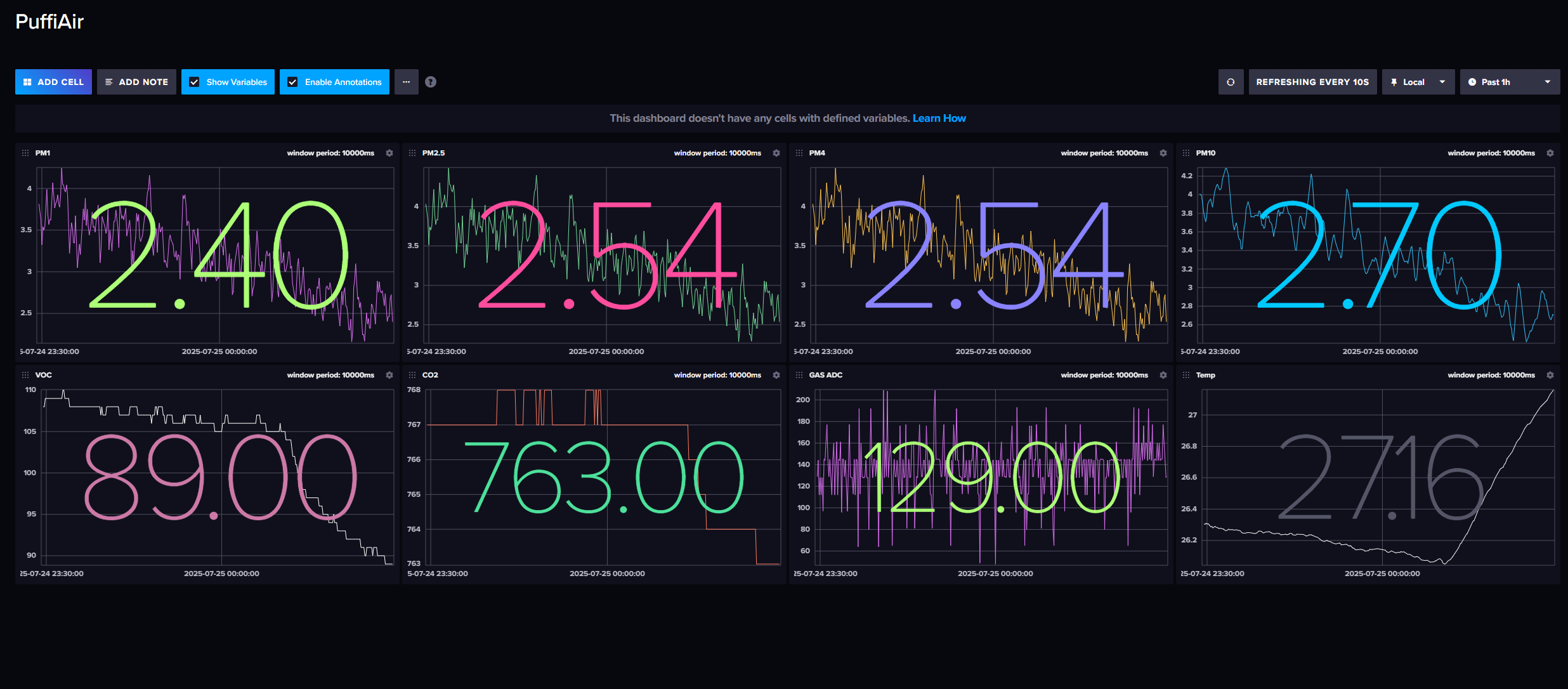PuffiAir Local Data Visualization Setup Guide¶
This guide walks you through the full process from installing InfluxDB to displaying PuffiAir sensor data on a webpage.

🧱 Step 1: Environment Preparation¶
sudo apt update
sudo apt install -y python3 python3-pip curl
Install Mosquitto MQTT Broker (or use Home Assistant's built-in MQTT service)
If you're already using Home Assistant and have MQTT enabled, you can use its built-in MQTT broker.
In this case, simply enter the MQTT settings of your Home Assistant instance (host, port, username, and password) into the PuffiAir configuration web page (AP mode).
⚠️ Note: You should either use Home Assistant's MQTT or a local Mosquitto server—not both. Choose one and ensure the MQTT settings in PuffiAir match the broker you are using.
sudo apt install -y mosquitto mosquitto-clients
sudo systemctl enable mosquitto
🌊 Step 2: Install and Configure InfluxDB 2.x¶
curl -sL https://repos.influxdata.com/influxdb.key | sudo gpg --dearmor -o /etc/apt/trusted.gpg.d/influxdb.gpg
echo "deb [arch=amd64] https://repos.influxdata.com/ubuntu $(lsb_release -cs) stable" | sudo tee /etc/apt/sources.list.d/influxdb.list
sudo apt update
sudo apt install influxdb2
sudo systemctl enable influxdb
sudo systemctl start influxdb
Open the setup UI in your browser: http://<your_ip>:8086
Initial setup values:
- Organization: puffilab
- Bucket: puffiair
- Token: Save this token for later
- Username / Password: Used for web access
🐍 Step 3: Python Script - MQTT → InfluxDB¶
Install Python dependencies¶
pip3 install paho-mqtt influxdb-client
Create the script file mqtt_to_influx.py¶
import json
from paho.mqtt.client import Client
from influxdb_client import InfluxDBClient, Point
from influxdb_client.client.write_api import SYNCHRONOUS
INFLUX_URL = "http://xxx.xxx.xxx.xxx:8086"
INFLUX_TOKEN = "your_token"
INFLUX_ORG = "puffilab"
INFLUX_BUCKET = "puffiair"
MQTT_BROKER = "localhost" # or your HA MQTT IP
MQTT_PORT = 1883
MQTT_TOPIC = "puffiair/data"
influx_client = InfluxDBClient(
url=INFLUX_URL,
token=INFLUX_TOKEN,
org=INFLUX_ORG
)
write_api = influx_client.write_api(write_options=SYNCHRONOUS)
def on_message(client, userdata, msg):
try:
data = json.loads(msg.payload.decode())
print("Received:", data)
point = Point("sensor")
for k, v in data.items():
try:
point.field(k, float(v))
except ValueError:
continue
write_api.write(bucket=INFLUX_BUCKET, org=INFLUX_ORG, record=point)
except Exception as e:
print("Error:", e)
mqtt = Client()
mqtt.connect(MQTT_BROKER, MQTT_PORT, 60)
mqtt.subscribe(MQTT_TOPIC)
mqtt.on_message = on_message
print(f"Subscribed to topic: {MQTT_TOPIC}")
mqtt.loop_forever()
Run the script (keep this running):
python3 mqtt_to_influx.py
📊 Step 4: Build a Simple Frontend Dashboard (optional)¶
Create an HTML file:
<!DOCTYPE html>
<html>
<head>
<meta charset="utf-8">
<title>CO₂ Chart</title>
<script src="https://cdn.jsdelivr.net/npm/chart.js"></script>
</head>
<body>
<canvas id="co2Chart" width="800" height="400"></canvas>
<script>
const token = 'your_token';
const org = 'puffilab';
const bucket = 'puffiair';
const url = `http://xxx.xxx.xxx.xxx:8086/api/v2/query?org=${org}`;
const fluxQuery = `
from(bucket: "${bucket}")
|> range(start: -6h)
|> filter(fn: (r) => r._measurement == "sensor" and r._field == "co2")
|> sort(columns: ["_time"])
`;
fetch(url, {
method: 'POST',
headers: {
'Authorization': `Token ${token}`,
'Content-Type': 'application/vnd.flux',
'Accept': 'text/csv'
},
body: fluxQuery
})
.then(res => res.text())
.then(csv => {
const lines = csv.trim().split('\n').filter(line => !line.startsWith('#'));
const timestamps = [];
const values = [];
for (let line of lines) {
const parts = line.split(',');
const time = parts[5];
const value = parseFloat(parts[7]);
if (!isNaN(value)) {
timestamps.push(new Date(time));
values.push(value);
}
}
new Chart(document.getElementById('co2Chart'), {
type: 'line',
data: {
labels: timestamps,
datasets: [{
label: 'CO₂ (ppm)',
data: values,
borderColor: 'rgba(75, 192, 192, 1)',
borderWidth: 2,
fill: false,
pointRadius: 0,
}]
},
options: {
scales: {
x: { type: 'time', time: { unit: 'hour' }, title: { display: true, text: 'Time' }},
y: { title: { display: true, text: 'CO₂ (ppm)' }}
}
}
});
})
.catch(err => console.error(err));
</script>
</body>
</html>
✅ Done!¶
Your PuffiAir is now logging to InfluxDB and viewable in browser.¶